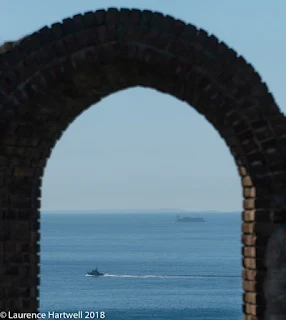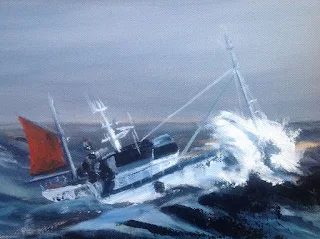The earliest was in Barbizon and the Forest of Fontainebleau; the most extreme in their modernity were in Brittany, and the most literal in Skagen (the northern tip of Denmark) and Cornwall. Gauguin, Van Gogh and Munch were among their celebrated visitors, but most residents were diligent plodders, professionals earning a living with their abilities reinforced by the shared enthusiasms of the group and, inevitably, their amateur hangers-on. There was no unifying manifesto, only a common conviction among the painters that they must paint in the open air, be true to nature with as much intensity as they could muster, be affected by neither poetry nor philosophy, but be pure naturalists.
The last quarter of the 19th century was, indeed, the heyday of Naturalism as distinct from Realism, which decades earlier had developed democratic and even socialist sub-texts and the political aspirations to reform society. Naturalism was to be the vehicle of the artist who had no reforming zeal but merely wished to reproduce what he perceived to be a suitable subject. There was in France some theoretical argument about these terms (and there is still confusion), but, put very simply, what Munch had to say about miners and Meunier (a much underrated Belgian) about workers in all industries, is political Realism, and what Forbes and his associates had to say about the rural poor is rustic Naturalism, though it is often tinged with sentimentality and Ruskin’s notion of the Pathetic Fallacy (the attribution of human feelings to Nature).
There is scant evidence that the painters of Newlyn and St Ives ever felt any social or political sympathy for their subjects, though Henry Tuke’s paintings of the local adolescent boys seem often to express emotional longing. These were painters who observed poverty and squalor and thought them picturesque; they had no wish to remove the innards and heads of fish that, discarded below every kitchen window, rotted in heaps, and they ignored the stink; nor did they think to endow the inhabitants with such abstractions as nobility and sacrifice. Forbes described Newlyn as “a dirty hole” in which artists had struck gold, a perfect Klondyke for artistic purposes. He and his friends nevertheless complained that the fishermen (who, in Brittany, had been picturesque) wore no local costume but simply tired old clothes, and that the pigtailed local women were, as models, even less rewarding in their tawdry Victorian haberdashery. Perhaps most of all, the artists, bent on amorous adventures as much as art, on dinners, dances and amateur theatricals too, resented the prohibitive low church religion of the Cornish fisherfolk, their “primitive Methodist bigotry”, their Sunday-keeping and abstinence from alcohol, “a most disagreeable set of people, full of hypocrisy and cant”.
These Europe-wide colonies were united by two things — their determination to paint on the spot and in the open air, and their admiration for Jules Bastien-Lepage (1848-1884), the French painter who was the high priest and proselytiser of plein-air painting, his peasant themes elevated to a highly personal form of Salon Naturalism that was astonishingly influential. Many of the painters working in Cornwall had been trained in Paris and knew well his technique of painting in subdued tones with square brushes and short strokes that left slivers of canvas visible and suggested something of the broken brushwork of the Impressionists, his immediate contemporaries (their exhibitions ran from 1874 to 1886). On his death from stomach cancer at the age of only 36 he had been far more immediately and widely influential than Picasso ever was to be, with adherents not only in Cornwall, but in Scotland, across all Scandinavia, in Russia, America and even Australia. Norman Garstin (1847-1926), who had trained in Antwerp and Paris, argued that Lepage had been the greatest artist of his day, “… almost all his contemporaries have felt his power; many imitated him, no one surpassed him”; and Forbes expressed much the same view with “… the greatest artist of our age is dead...his influence...already so great, will become more powerful than ever.” Perceived to be the master of the impartial presentation that was the aim of the Naturalists of Newlyn, Lepage was by unsubtle implication as much a teller of stories as any Pre-Raphaelite (see his Love in the Village), and for pure Naturalism we should look at the work of Léon Lhermitte (1844-1923), now ignored, but admired by Van Gogh as a second Millet (who also lurks in the background of Naturalism, though with a devout religious bent).
For pure Naturalism, sans political pleading, sans touching narrative, the presentation utterly impartial, we need only turn to A Fish Sale by Stanhope Forbes, dated 1885 but mostly the work of 1884, the year of his arrival in Newlyn. The idea, generated in February and developed in sketches, was to have been a canvas nine feet wide, but in June this was reduced to one five feet by four. In December it was still a work in progress — “I got blown about and rained upon, my model fainted …” Forbes wanted grey days and got them, seeing the sea and the wet sands as the mirror that could extend the flat undramatic light into every corner of the canvas, muting to mere tone what scraps of colour might be found in any detail.
For a painter aged 27, as yet of no reputation, A Fish Sale is an ambitious and complex painting, far beyond the technical ability of any painter of that age now. It is casually classical in composition, as though The School of Athens, painted by Raphael when he too was 27, lurks in suppressed memory. The auctioning of fish takes place in the distance, reduced to insignificant incident; it is counter-balanced by the play of sails against the horizon on the left, distance scrupulously indicated by smaller figures, a rowing-boat, and faint sails far out on the right. The prime subject is the non-narrative of the three figures in the foreground and the by no means casual still life of dead fish at their feet. Far from informal, this is a composition so carefully constructed that no detail is superfluous, a precocious example of Newlyn Naturalism.
Few of Forbes’s friends achieved or maintained such a level of detachment; some drifted into sentimental narratives with such titles as A Hopeless Dawn, For Men Must Work and Women Must Weep, and Never Morning Wore to Evening but Some Heart Did Break; a few painted pictures of record documenting the hardships of the fishermen and the prodigal richness of their catches; but the work of most was scarcely distinguishable in subject and sentiment from that of such other late Victorian celebrity painters as Fildes and Herkomer. By the end of the 19th century the first incarnation of both Newlyn and St Ives as important forces in English art had fizzled out with only Forbes, having established an art school in Newlyn in 1899, surviving longer as an influence; there was also a school in St Ives — it is perhaps not unkind to say that both were for the benefit of young ladies.
In the 20th century there were second incarnations. Newlyn became the haunt of another generation of comfortably off and roistering young artists — Harold Harvey, Lamorna Birch, Dod and Ernest Procter, Frank Dobson and Alfred Munnings, with Harold and Laura Knight swanning about in a big Belize the size of a Rolls-Royce and having new furniture sent from Harrods; most faded away from Newlyn and by the end of the Thirties it was no longer an artists’ community. St Ives, which in the 1890s had some small reputation with American and Scandinavian artists, Whistler and Zorn among them (and Sickert too), began to revive in the Twenties as Newlyn declined, and its long heyday dragged on from c1930, through several decades of English Modernism, until it fizzled out again. Fizzling out was, of course, the fate of all the other colonies that had been examples of this “wave of feeling”.
This exhibition is promoted as “re-approaching” (a word that I took to mean re-examining) “the work of pioneering Newlyn and St Ives artists widely regarded to be an English response to Impressionism … [and] the founding of artistic colonies …” This has been my approach too, for in reminding us of these artists’ communities it reveals their passion for painting in the open air, their reverence for Bastien-Lepage, their resistance to Impressionism and their concern for Realism and Naturalism. The exhibition’s title, however, is Amongst Heroes: The Artist in Working Cornwall, and its catalogue is all but entirely about the workers and their sweated industries, the paintings treated as mere illustrations to “an historical geography of work in Cornwall”. This is the long discredited between-the-wars Marxist art history of Frederick Antal — what-about-the-workers stuff and never mind the art — all the more ludicrous in that the artists cared not a fig for the plight of the workers who, they grumbled, asked twice as much to pose as models as their counterparts in Brittany, and whom they painted with an eye on the Royal Academy and the rich patronage it might bring them.
In the opulent setting of a contemporary London mansion completed for the American millionaire William Waldorf Astor in 1895 (a man of specifically literary bent), which has been in use as a public art gallery since 2011, this Marxist historical geography must seem to all sane men anomalous. It is — though the impoverished fishermen in the wooden boats of Newlyn would have appreciated the craftsmanship of the hammerbeam roof over the panelled Great Hall. Even Antal would have seen the joke.
Amongst Heroes: The Artist in Working Cornwall opens at Two Temple Place, WC2 (020 7836 3715, twotemple place.org) from January 26 to April 14. Open Mon, Thurs-Fri & Sat, 10am-4.30pm; Weds, 10am-9pm; Sun, 11am-4.30pm; closed Tues. Admission free
.jpg)




















































